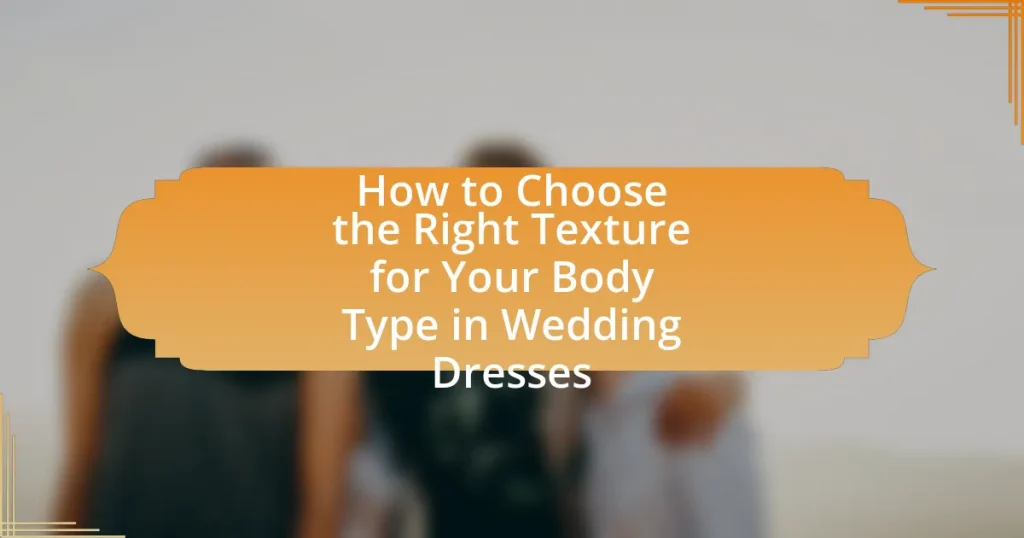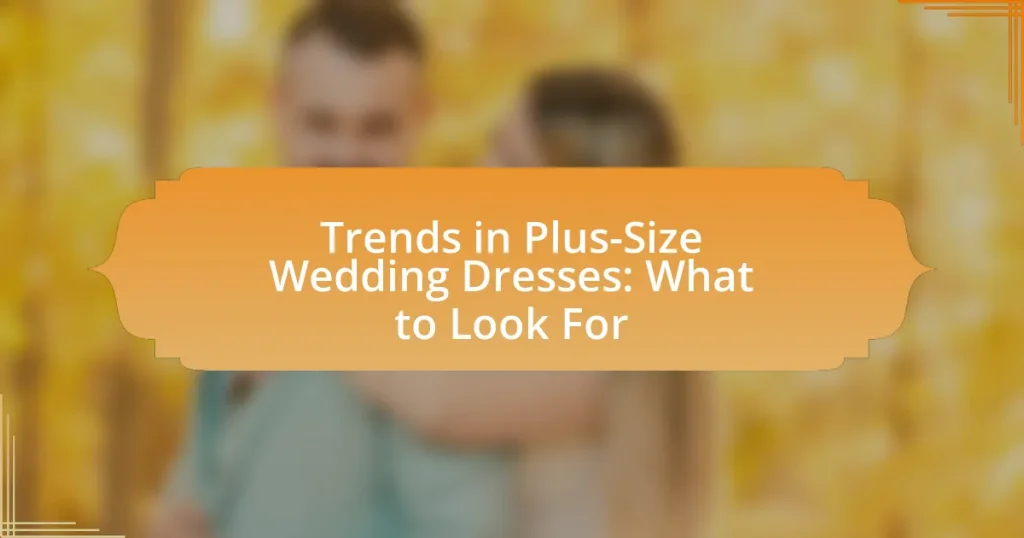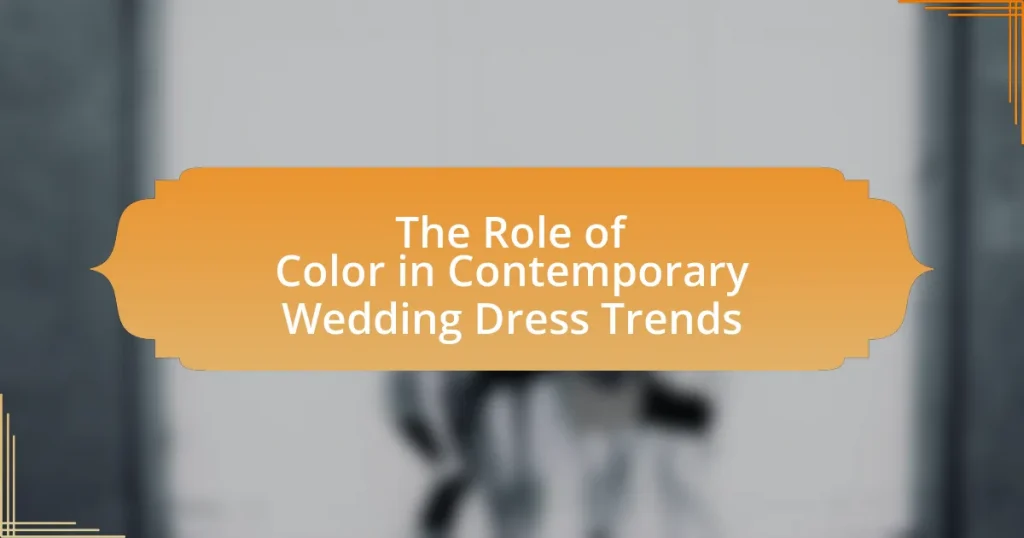The article focuses on how to choose the right texture for wedding dresses based on body type. It emphasizes the importance of assessing body shape and selecting fabrics that enhance features, such as structured materials for hourglass figures and softer textures for rectangular shapes. Key factors discussed include the influence of fabric weight on silhouette and comfort, the characteristics of popular textures like lace, satin, and chiffon, and best practices for aligning texture choices with personal style and wedding themes. The article provides practical tips for brides to ensure their dress complements their body type while maintaining comfort and aesthetic appeal.
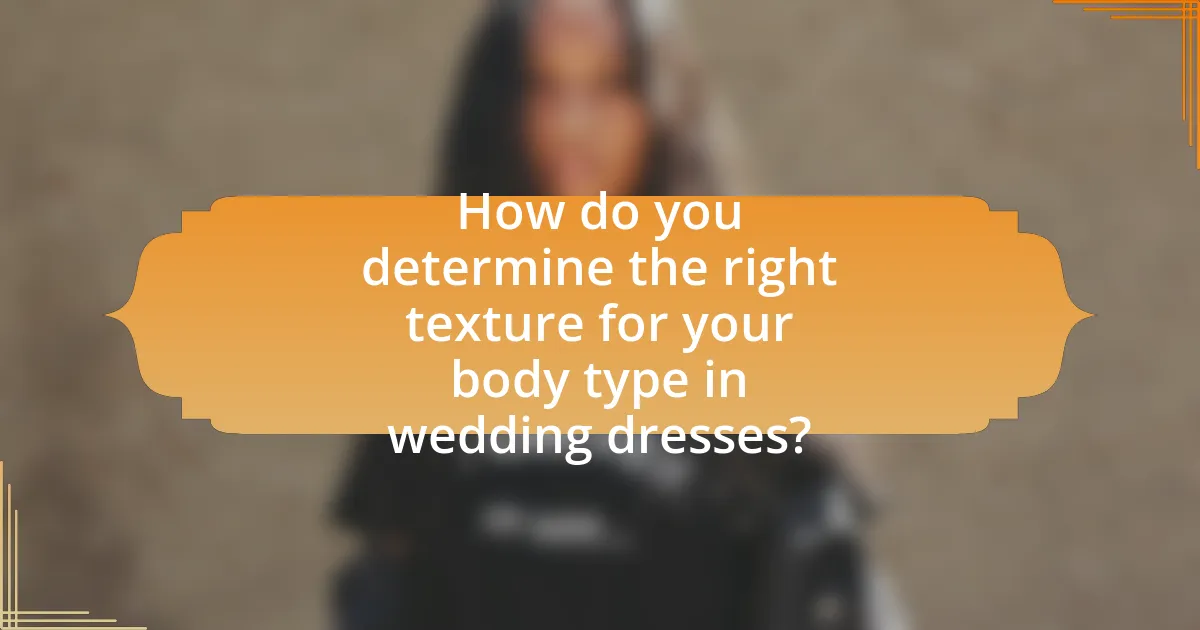
How do you determine the right texture for your body type in wedding dresses?
To determine the right texture for your body type in wedding dresses, assess your body shape and choose fabrics that enhance your features. For example, if you have an hourglass figure, structured fabrics like satin or taffeta can accentuate your curves, while softer textures like chiffon or lace may suit a more rectangular body shape by adding volume and movement. Additionally, consider the weight of the fabric; heavier materials can provide support and shape, while lighter fabrics can create a flowing silhouette. This approach is supported by fashion experts who emphasize the importance of fabric choice in complementing body types, ensuring a flattering fit and overall aesthetic.
What factors should you consider when choosing a texture?
When choosing a texture for wedding dresses, consider the body type, fabric drape, and overall aesthetic. Body type influences how different textures complement or contrast with the figure; for example, structured fabrics like satin can enhance curves, while softer materials like chiffon may create a more flowing silhouette. The drape of the fabric affects movement and comfort; heavier textures may provide a more formal look, while lighter ones can offer ease and elegance. Additionally, the overall aesthetic should align with the wedding theme and personal style, ensuring that the chosen texture harmonizes with the dress design and enhances the wearer’s appearance.
How does your body shape influence texture selection?
Body shape significantly influences texture selection in wedding dresses by determining which fabrics and patterns enhance or flatter specific silhouettes. For example, curvier body shapes may benefit from textured fabrics like lace or tulle that add dimension and create a balanced look, while straight body shapes might opt for smoother textures like satin or chiffon to create the illusion of curves. Research indicates that the right texture can enhance body proportions, as seen in studies on fashion and body image, which show that certain textures can visually alter perceptions of body shape.
What role does fabric weight play in texture choice?
Fabric weight significantly influences texture choice in wedding dresses by determining how the fabric drapes and feels against the body. Heavier fabrics, such as satin or taffeta, provide structure and can create a more formal look, while lighter fabrics like chiffon or organza offer a flowy, ethereal quality. The choice of fabric weight directly impacts the overall silhouette and comfort of the dress, as heavier materials may restrict movement, whereas lighter options allow for ease and breathability. This relationship is crucial for achieving the desired aesthetic and fit, ensuring that the dress complements the wearer’s body type effectively.
Why is texture important in wedding dress design?
Texture is important in wedding dress design because it significantly influences the overall aesthetic and fit of the gown. Different textures, such as lace, satin, or tulle, can enhance or detract from the silhouette, creating visual interest and depth. For instance, lace adds a romantic and intricate detail, while satin provides a smooth and elegant appearance. The choice of texture also affects how the dress drapes on the body, which is crucial for flattering various body types. Research indicates that the right texture can enhance body proportions, making it essential for brides to consider their unique shapes when selecting a wedding dress.
How does texture affect the overall silhouette of the dress?
Texture significantly influences the overall silhouette of a dress by altering its visual weight and structure. Different textures, such as smooth satin or textured lace, can create varying levels of volume and shape, impacting how the dress falls on the body. For instance, heavier fabrics like brocade can add structure and formality, enhancing a structured silhouette, while lighter, flowing materials like chiffon can create a softer, more ethereal look. This relationship between texture and silhouette is crucial in wedding dress design, as it helps to complement the wearer’s body type and desired aesthetic.
What impact does texture have on comfort and movement?
Texture significantly influences comfort and movement in wedding dresses. Fabrics with a smooth texture, such as silk or satin, allow for ease of movement and reduce friction against the skin, enhancing overall comfort. In contrast, rougher textures, like lace or tulle, may restrict movement and cause discomfort if they do not align with the wearer’s body type. Studies indicate that the choice of fabric texture can affect the wearer’s physical ease and emotional confidence, impacting their overall experience during events like weddings.
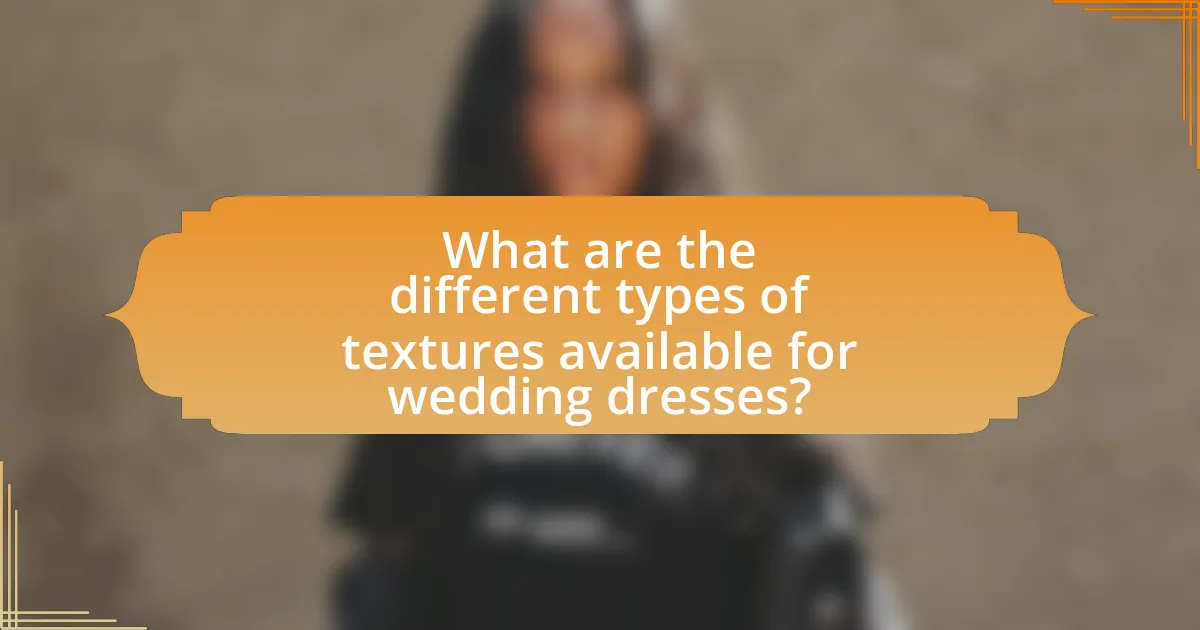
What are the different types of textures available for wedding dresses?
The different types of textures available for wedding dresses include lace, satin, tulle, chiffon, organza, and mikado. Lace offers a delicate and intricate design, often used for overlays or accents, while satin provides a smooth and luxurious finish that drapes beautifully. Tulle is lightweight and airy, commonly used for skirts and veils, whereas chiffon is soft and flowing, ideal for creating romantic silhouettes. Organza is a crisp, sheer fabric that adds structure, and mikado combines silk and nylon for a rich texture with a slight sheen. Each texture contributes uniquely to the overall aesthetic and fit of the wedding dress, allowing brides to choose based on their personal style and body type.
What are the characteristics of popular wedding dress textures?
Popular wedding dress textures include satin, lace, tulle, chiffon, and organza, each with distinct characteristics. Satin is smooth and luxurious, providing a structured silhouette that enhances body shape. Lace features intricate patterns and a delicate appearance, often used for romantic and vintage styles. Tulle is lightweight and airy, creating volume and a whimsical effect, ideal for ball gowns. Chiffon is soft and flowing, offering a graceful drape that flatters various body types. Organza is crisp and sheer, adding a structured yet ethereal quality to designs. These textures not only influence the aesthetic of the dress but also affect comfort and movement, making them essential considerations when choosing a wedding gown.
How does lace texture enhance a wedding dress?
Lace texture enhances a wedding dress by adding intricate detail and elegance, which elevates the overall aesthetic. The delicate patterns and designs of lace create visual interest and depth, making the dress appear more luxurious. Additionally, lace can provide a romantic and timeless quality, often associated with traditional bridal wear. Studies show that lace is a popular choice among brides, as it complements various body types by offering both structure and softness, allowing for a flattering silhouette.
What are the benefits of satin versus chiffon textures?
Satin offers a luxurious, smooth finish that drapes beautifully, making it ideal for structured designs and formal occasions. In contrast, chiffon is lightweight and sheer, providing a soft, flowing appearance that enhances movement and is perfect for layered styles. Satin’s heavier weight allows for more defined silhouettes, while chiffon’s airy quality creates a romantic, ethereal look. These characteristics make satin suitable for more formal wedding dresses, while chiffon is often chosen for bohemian or casual styles.
How do different textures complement various body types?
Different textures enhance various body types by creating visual balance and emphasizing or downplaying specific features. For example, structured fabrics like taffeta or satin can provide support and shape to curvier figures, while flowing materials such as chiffon or lace can soften angular body types. Textures like ruffles or embroidery can add dimension and interest, making them suitable for those with a more slender frame, as they create the illusion of curves. Conversely, smooth textures can elongate and streamline the silhouette, which is beneficial for petite body types. This understanding of how textures interact with body shapes is supported by fashion industry practices that emphasize the importance of fabric choice in achieving a flattering look.
Which textures are best suited for hourglass figures?
Soft, structured, and draped textures are best suited for hourglass figures. These textures enhance the natural curves of the body, providing balance and definition. Fabrics like satin, silk, and chiffon are ideal as they drape elegantly over the silhouette, while structured materials such as taffeta and organza can create a defined waistline. The use of these textures helps to accentuate the hourglass shape, making it visually appealing and flattering.
What textures work well for pear-shaped bodies?
Soft, flowing textures such as chiffon, silk, and jersey work well for pear-shaped bodies. These materials drape elegantly over the hips and thighs, creating a balanced silhouette. Additionally, structured fabrics like taffeta and organza can provide support and shape, enhancing the waist while allowing for a fuller skirt that complements the pear shape. The use of these textures helps to draw attention to the upper body and create a harmonious overall look, which is essential in wedding dress design for this body type.
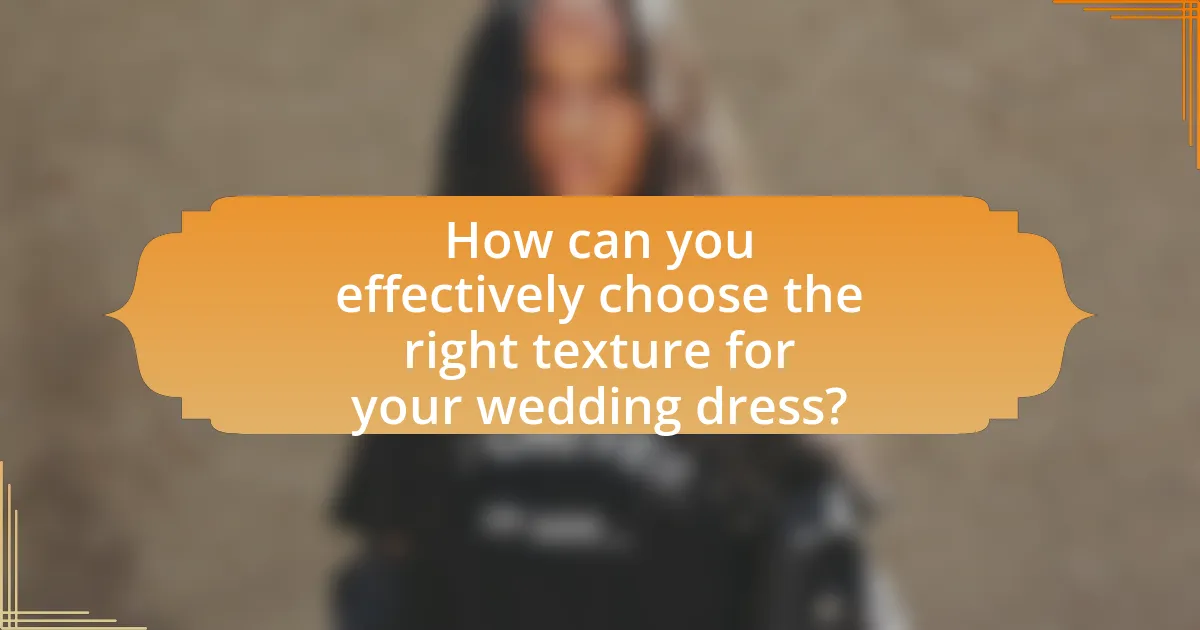
How can you effectively choose the right texture for your wedding dress?
To effectively choose the right texture for your wedding dress, consider your body type and the overall aesthetic you desire. Different textures, such as lace, satin, or tulle, can enhance or detract from your silhouette. For example, lace adds dimension and can create a romantic look, while satin offers a sleek and elegant appearance. Additionally, heavier fabrics like brocade can provide structure, which may be beneficial for curvier body types, while lighter fabrics like chiffon can flatter a more slender frame. Understanding how each texture interacts with your body shape will help you make an informed decision that complements your figure and personal style.
What tips can help you select the perfect texture?
To select the perfect texture for wedding dresses, consider the body type and the desired aesthetic. For example, lightweight fabrics like chiffon or organza create a soft, flowing look ideal for slender figures, while structured materials like satin or taffeta provide support and shape for curvier body types. Additionally, assess the season and venue; heavier textures suit winter weddings, while lighter fabrics are better for summer events. The right texture enhances comfort and complements the overall design, ensuring the dress fits well and looks flattering.
How can you incorporate personal style into texture choice?
Incorporating personal style into texture choice involves selecting fabrics that reflect individual preferences and enhance body type. For example, if someone prefers a romantic aesthetic, they might choose soft lace or flowing chiffon, while a modern style may lean towards structured satin or sleek crepe. Personal style can also be expressed through the combination of textures; mixing matte and shiny fabrics can create visual interest and align with one’s unique fashion sense. Ultimately, the choice of texture should resonate with the wearer’s personality and complement their body shape, ensuring both comfort and confidence on their wedding day.
What should you keep in mind when trying on different textures?
When trying on different textures for wedding dresses, you should consider how each texture interacts with your body shape and enhances your features. Textures like lace, satin, and tulle can create different visual effects; for example, lace adds dimension and softness, while satin offers a sleek silhouette. Understanding your body type is crucial, as certain textures can either flatter or overwhelm your figure. For instance, structured fabrics may provide support for curvier shapes, while flowy materials can complement slimmer figures. Additionally, consider the season and venue, as heavier textures may be unsuitable for warm weather or outdoor settings.
What common mistakes should you avoid when choosing texture?
When choosing texture for wedding dresses, common mistakes to avoid include selecting textures that do not complement body shape, overlooking fabric weight and drape, and ignoring personal comfort. Choosing a texture that clashes with body type can create unflattering silhouettes; for instance, heavy fabrics may overwhelm a petite frame. Additionally, neglecting the importance of fabric weight can lead to discomfort, as lighter fabrics may not provide adequate support for certain designs. Lastly, prioritizing aesthetics over comfort can result in a negative experience on the wedding day, as uncomfortable textures can hinder movement and enjoyment.
How can you ensure the texture aligns with your wedding theme?
To ensure the texture aligns with your wedding theme, select fabrics that complement the overall aesthetic of your event. For instance, if your wedding theme is rustic, opt for textured materials like lace or burlap, which evoke a natural feel. Conversely, for a modern theme, sleek fabrics such as satin or silk can enhance a contemporary look. Research indicates that the choice of fabric significantly impacts the visual coherence of wedding attire, as textures can either harmonize or clash with the theme, affecting the overall ambiance.
What are the pitfalls of ignoring body type in texture selection?
Ignoring body type in texture selection can lead to unflattering silhouettes and discomfort. When individuals choose textures that do not complement their body shape, it can accentuate undesirable areas or create an imbalanced appearance. For example, heavier fabrics may overwhelm a petite frame, while lightweight materials may not provide enough structure for curvier body types. This mismatch can result in a lack of confidence and dissatisfaction with the overall look. Additionally, certain textures may not drape well on specific body types, leading to issues such as bunching or sagging, which detracts from the intended aesthetic of the wedding dress.
What are the best practices for selecting wedding dress textures?
The best practices for selecting wedding dress textures involve understanding body types and fabric characteristics. Different textures can enhance or detract from a silhouette; for example, lightweight fabrics like chiffon and organza create a soft, flowing look ideal for petite figures, while structured fabrics like satin and taffeta provide support and shape for curvier body types. Additionally, consider the season and venue; heavier textures are suitable for winter weddings, while lighter fabrics work well in summer. Research indicates that the right texture can significantly impact the overall appearance and comfort of the dress, making it essential to choose fabrics that complement both the body type and the wedding theme.
